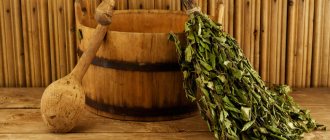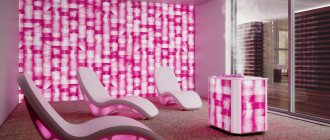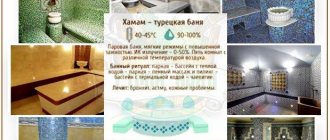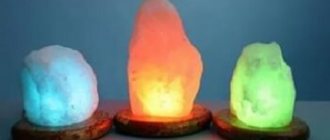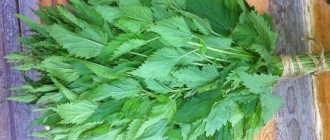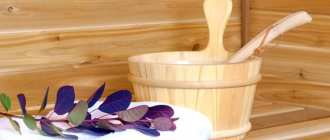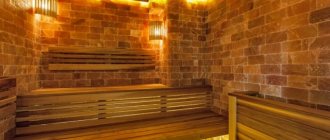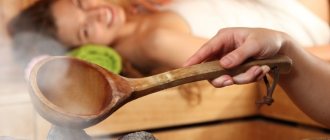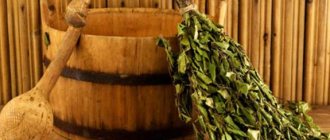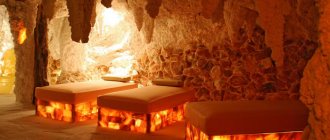Features and finishing requirements
Why do you need finishing in a bathhouse? This question arises often, especially when carrying out work in a room that is a log house. The log surface of its walls is quite decorative in itself. Let us give a number of arguments why finishing is still necessary in conditions of high humidity and temperature. It performs the following functions:
- protects walls from moisture;
- behind it you can hide thermal insulation and waterproofing, providing an even greater degree of protection;
- compensates for the heating of surfaces and prevents getting burned, thereby increasing the level of comfort for visitors;
- has a variety of therapeutic and preventive effects depending on the type of wood;
- Decorative finishing makes staying in the bathhouse not just useful, but also enjoyable.
Step-by-step plan for interior work:
- We cover the walls, ceiling and floor with lumber in sequence.
- We line the stoves.
- We construct benches in the steam room.
When choosing the optimal wood for finishing a bath, you need to be guided by certain parameters. Products must have the following qualities:
- resistance to high temperatures and humidity;
- safety when contacting people;
- durability;
- ease of processing;
- reasonable cost.
Finishing boards must be dried to a moisture content of 10% and subjected to thermal exposure. These procedures help improve their performance characteristics.
The mechanism of action of hot air on the human body
As soon as the ambient temperature rises above 37 degrees, our body instantly starts an active process of sweating , thereby protecting the body from overheating. It is this principle that is taken into account in the bathhouse. By releasing sweat through the skin, a person cleanses his body of unnecessary and harmful substances.
The higher the temperature of the environment where a person is, the more intense the sweat comes out through the opening pores. To avoid overheating of the skin and internal systems, blood circulation is activated, which can be identified by characteristic redness. Blood begins to circulate intensively throughout the body, supplying all organs with additional portions. As you know, the more blood flows to a certain area of the skin, the more useful substances it will receive. During a visit to the bathhouse, the entire human skin . There is also a downside to this miraculous mechanism - the loss of a large number of microelements, which are washed out later through the skin pores.
That is why you need to consume a large amount of liquid in the bath. You should not pour a huge volume of water into yourself at once. You need to drink in small sips, taking breaks, then the liquid will not leave immediately through the kidneys, but will be evenly distributed throughout the body, compensating for what came out through the skin.
Many connoisseurs of the Russian bath like to dive into a cold ice hole or jump into the snow immediately after the steam room. Is it correct? In this case, the pores instantly narrow. The hot blood that was in the skin due to the closing pores moves into the deeper layers of the skin. The temperature of these layers increases. The next visit to the steam room includes the process of cleaning these layers. Such cycles are repeated several times.
Bathhouse premises and their functionality
Even the smallest bathhouse should be divided into several rooms. This allows you to select separate zones with different functionality, maintain the required level of temperature and humidity in each of them, and make the use of all options comfortable and safe.
Traditionally, a bathhouse consists of:
- dressing room - prevents cold air from entering the room and warm air from leaving it. This is a mandatory element of construction. If it is not possible to equip a full-fledged vestibule, you can get by with a miniature nook with two doors opening in different directions. You can arrange a changing room in the dressing room - place small benches and a hanger so that you can leave clothes and change shoes. If the vestibule is combined with a rest room, then there may be a table, equipment for broadcasting video and audio, a grill and much more;
- washroom - a room separated by a door from the steam room. A comfortable temperature is maintained here. Washing in a hot steam room with a hot stove is difficult and unsafe. In addition, it is much more difficult to thoroughly warm a large room than an isolated space of 3-4 square meters. m. The size of the washing room depends on its purpose and the number of family members. If you plan to use it also as a laundry room, or you are going to bathe several children at the same time, you will need a spacious room. If the bathhouse is being built in a country house and is intended for meetings with friends, a shower in one of its corners will be enough, and half a square meter will be enough for this;
- The steam room is the main room - the “heart” of the Russian bath. It has no windows and is located as far as possible from the entrance. It contains a stove that heats the room. There are also shelves to accommodate people. They can be shortened - intended only for sitting and long. On horizontal beds you can steam, stretching out to your full height. If you need to make the most of a small space, you can install a cascading shelf structure on several “floors”.
Selection of material for thermal insulation
In order to ensure high-quality thermal insulation of a log or brick bathhouse and avoid the formation of condensation, it is recommended to use the following materials:
- foiled mineral wool is one of the most effective heat insulators in the mid-price category. Of all types of wool, basalt wool is best suited for insulating baths. It has minimal thermal conductivity and high durability. The material is presented in the form of plates or rolls with a thickness of 5 to 10 cm, equipped with one layer of foil. To install it, you need to build a frame of wooden planks;
- penotherm - the base is foamed polypropylene, onto which one layer of foil is applied.
Significantly speeds up the process of heating the steam room to the required temperature and retains heat for a long time. The material is safe for humans because it does not contain toxic substances. It was specially developed for thermal insulation of baths, so it is not afraid of the heat of a steam room. Attaches directly to the wall using a stapler and then secures with lathing for finishing.
Materials used for finishing
The choice of materials for interior decoration depends on various factors. This is influenced by the type of bath, the characteristics of various materials, and the size of the budget. In any case, it should contribute to a comfortable stay, be cozy, aesthetic and functional. If you wish, you can do the finishing work yourself and invest the allocated money in more expensive materials.
Give preference to quality products. This will ensure maximum safety and health for you and your family.
Wall and ceiling finishing
For cladding walls in wet rooms - washrooms and steam rooms - you cannot use particle boards, linoleum and other chemical industry products. Natural wood should reign here. For walls, lining or tongue-and-groove boards made of cedar, linden, aspen, larch, and abacha are suitable. The surfaces in the steam room must not be coated with varnish or paint - when heated, their fumes can lead to toxic poisoning.
In the washing compartment, the walls can be lined with inexpensive pine clapboard or tiled. In a brick bath, installing tiles will not cause difficulties, but in a wooden bath you will need to create a base from sheets of moisture-resistant plywood, gypsum board or OSB.
Slats made of cedar, linden, and aspen are suitable for finishing the ceiling.
Floor finishing
The process of arranging the floor is as follows. The first step is to install the logs. They are made from 200x200 mm timber. A board is laid on top - edged or tongue-and-groove, with a tongue-and-groove system. When heated strongly, coniferous wood releases resin. Therefore, it is better to choose lumber made from hardwoods other than oak. The optimal choice is larch. Small gaps are left between the joints, which are useful for ventilation and removal of excess water. This is especially important for a washroom.
The floor in the steam room must be raised 15-20 cm from the main level. This is done to prevent unnecessary heat loss.
To protect boards from fungus, they are treated with antibacterial compounds. In order to prevent swelling, they are coated with a primer. You can install a drain and make the floor with a slight slope towards the drain.
Matte or grooved tiles are perfect for the floor in a brick bathhouse.
Characteristics of wood used for finishing steam rooms
The comfort and safety of its visitors depends on the correct choice of finishing material for the bathhouse. Traditionally, natural wood is used - an environmentally friendly and affordable raw material. Bath culture originated a long time ago and since then a lot of knowledge has accumulated about the properties of this or that wood. Each of them has special characteristics and healing qualities that allow you to create a unique microclimate in the steam room. There are many options for wood that can be used to decorate a bathhouse. These include the familiar linden, alder, larch, birch and exotic Abacha oak. Let's figure out how they differ and which breeds are better suited for a particular bathhouse.
African abacha oak
The African Abacha oak is a member of the malvaceae family. It is also called abashi, ayous, samba. This tree is capable of reaching gigantic sizes - the height of its trunk can reach up to 40 m, and its diameter up to 3 m. Abacha has durable wood with a dense and even texture. It retains its shape well and is easy to process due to the absence of knots - the crown is located at the very top of the tree. This is an expensive material, comparable in cost to mahogany, but its remarkable qualities allow it to remain very in demand and popular.
Properties of Abacha wood. The main advantage of this material is its low ability to conduct heat. Thanks to this, rooms with such finishing will remain cool in summer and warm in winter. In a bathhouse, this feature manifests itself as follows: the boards practically do not heat up, so it is impossible to get burned while sitting on an abacha shelf. In contact with the human body, wood takes on the temperature of his body. In addition, it does not release resinous substances, even with strong heating.
The positive characteristics of African oak do not end there. The list of its advantages includes resistance to:
- deformation during drying;
- mechanical damage;
- shrinkage;
- color change with prolonged use;
- high humidity - the boards remain dry even at a humidity of 12%. They practically do not absorb water, even from the end sides
Abacha oak is easy to process, which can be done with your own hands. Thanks to its dense structure, cracks do not form in it when driving nails, and the screws are screwed in well and held securely. Lumber can be easily glued and tinted. In the interior they go well with other types of wood.
Abacha wood is an expensive commodity. If you decide to decorate your bathhouse with this particular material, be careful - choose a really high-quality product.
Cedar
Noble cedar is the choice of aesthetes. Finishing from this material looks expensive and impressive. Light ocher-yellowish cedar wood has a smooth and beautiful texture. The annual rings and resin ducts are clearly visible on it. Cedar is a natural antiseptic. The finish made from its wood makes the air sterile and cleanses it of harmful bacteria. Essential oils have a beneficial healing effect on human health and fill the room with a wonderful pine aroma.
The wood has a high density and at the same time softness, which makes it easy to process and is not afraid of moisture, temperature changes, exposure to fungus and insects.
The disadvantages of the material include its high cost and insufficient aroma persistence. It is noted that the smell disappears within six months after the start of use of the bathhouse.
Alder
Alder wood is very popular. It has one of the most important qualities for a steam room - it does not heat up too much. Thanks to this, you can ensure that you and your loved ones will not get burned when touching wooden surfaces. Immediately after cutting, the wood has a light shade that magically changes upon contact with air. It acquires a reddish tint, which makes it similar to more valuable species - cherry, walnut. The unique aroma of alder is reminiscent of the smell of cognac, and like the latter, its richness and nobility only intensify over time.
Finishing made from this wood is excellent for a bathhouse, since it is not afraid of humidity and temperature changes. No resin is released from it, and this is very important for a hot room. The only difficulty is to choose high-quality material - smooth, defect-free alder paneling at reasonable prices.
Larch
Reddish larch wood contains many substances beneficial to the human body. This material has high mechanical properties and can honestly serve for decades. Elevated temperature and humidity are not scary for her. Among the disadvantages of larch is the difficulty in processing - due to the large number of knots and low thermal insulation ability.
The cost of wood is quite adequate to its characteristics. The long service life will more than pay for the investment made.
Linden
In Russia, this tree has long been revered for its beneficial properties. Its fragrant, pale pink wood is very popular and is often used to decorate baths. It compares favorably with other breeds with its even structure and characteristic shine. Linden is easy to process because it is a soft wood and does not create cracks during the process. The relatively low density of the material increases with decreasing humidity.
A steam room decorated with linden wood has healing properties and is recommended for the prevention of diseases of the respiratory organs, in particular the lungs.
A humid environment may cause the wood to gradually change color, but this will not affect its strength and durability. If handled carefully, the linden finish will give you many years of enjoyment. The cost of the material cannot be called too low, but it is not too high either. Therefore, it is suitable for most bath lovers who want to set up their own steam room.
Aspen
Aspen occupies a leading position among Russian deciduous species and is second only to birch. Its white wood with a subtle bluish-greenish tint has a uniform structure, softness, and straight grain. Lining and other lumber made from aspen are light in weight and can be easily processed - cutting, turning, and are resistant to abrasion. Due to their strength, durability, and excellent ability to retain heat, they are widely used in the improvement of baths and saunas. Aspen shelves do not overheat and do not burn.
The main advantage of this material is that being in water for a long time does not damage its integrity and does not “lead” after drying. That is why aspen was often used in the manufacture of well logs.
Birch
Birch wood has a pinkish or yellowish with white tint. Old trees boast a light brown cut color with a soft, luminous sheen. Winding fibers combined with dark inclusions form an interesting pattern. Birch has a homogeneous, dense and elastic structure. Thanks to this, it is easy to process not only with machines, but also with ordinary hand tools.
A bathhouse decorated with birch boards helps relieve fatigue and feel a surge of energy. Regular visits to such a steam room increase the body's resistance to colds.
Unfortunately, this material will not last long in “wet” rooms, since high humidity and heat are extremely harmful to it. It would be much better suited for a rest room. You can extend the life of birch trim using special treatment that will prevent rotting.
Ash
Ash is the owner of hard, heavy and strong wood. The light brown heartwood with an olive-brown tint gradually blends into the yellowish-pinkish sapwood. Large vessels make the wood texture very impressive and beautiful. When dyed, the fiber pattern becomes even more expressive and contrasting. The material is highly resistant to moisture and is characterized by moderate drying. It lends itself well to processing and polishing.
Picturesque texture, high strength, hardness, low water permeability, resistance to deformation, high impact strength, resistance to fungus and insects. All these qualities allow ash to stand on the same level as oak and even surpass it in some respects. It is these properties that make it possible to widely use its wood in the production of building materials, which are very useful when arranging a bathhouse. This is eurolining, imitation of timber, logs, in other words - a block house.
Preparation of brooms
They start knitting brooms around June-July in dry weather. When we meet a person with a broom under his arm, we immediately understand where he is going and don’t ask any questions. Everything is clear and without unnecessary words. A person who is not captivated by the bathhouse with its steam room and the aroma of a steamed broom will not fully understand the beauty of the art of steaming a hot body. This is not torture or masochism, but real art.
To get the maximum benefit from this procedure, you need to steam correctly and competently, and this is scientifically proven.
Correct and competent whipping with a broom
- This is a massage of body parts, which significantly increases blood circulation, increases sweating, and accelerates metabolism. Through enlarged pores, harmful toxins and microorganisms are washed out of tissues.
A bathhouse without steam is like cabbage soup without brew.
Under the influence of high temperature, the leaves begin to release essential oils. They inhibit the aging process of the skin. It is better to collect in the first half of the day, when the dew has dried.
For these purposes, they try to cut thin flexible branches from young birch trees with delicate fragrant leaves on flexible long branches and knit them in the shape of a fan, not a broom. Then such a fan-shaped broom will not fly away in different directions when floating.
Oak brooms are rougher due to thick branches and large leaves.
Brooms tied in pairs are hung under a canopy in the shade. This helps preserve active medicinal substances. The leaves of a properly tied broom after drying are dark green in color with an aroma when steamed in hot water.
The young broom is not steamed in hot water so that the tender leaves do not become limp. A dry broom is dipped in cold and then hot water for 10-20 minutes.
They steam with a damp broom with smooth, soft movements, lightly touching the body, periodically lowering it into the water. The broom plays the role of a fan.
You need to be especially careful when working with a broom at temperatures of 60 degrees or higher, so as not to burn anyone with hot air.
This massage makes blood and lymph move faster throughout the body. The released phytoncides kill pathogenic bacteria, and the essential oils in the leaves and branches enhance metabolism, preventing premature aging of the skin.
Design, decoration and equipment of premises
The choice of design depends on the preferences of the future owner, the size, nature and purpose of the functional areas inside the bathhouse.
Steam room design
The interior of the steam room should ensure the comfort and safety of visitors. The accessibility of elements, straight and rounded lines of its filling will certainly make the room as comfortable and ergonomic as possible.
The main space is given over to shelves. To make them, narrow wooden planks are used, which are stuffed at a certain pitch. Gaps are necessary for proper air circulation and quick drying of wet boards. In addition, the gaps make the structure more elegant, light and airy.
It is better to organize lighting using small built-in or pendant lamps with soft diffused light. Lampshades made of wooden slats are ideal for the decoration of the room.
A stove-heater is an essential element of a steam room. There are many variations in its design and location. The choice and placement of the heater depends on the size of the room, its configuration, and the location of functional areas. If the heater must heat two adjacent rooms, then it must be placed between them. In a polygonal grill sauna, the stove is installed in the middle, and the chimney is led out through the center of the roof.
The decoration of the steam room will become more impressive if you alternate slats from different types of wood. Aspen inserts become even darker over time, so the wooden mosaic will become more contrasting and more expressive. Inserts made of brick, glass or marble, placed in hard-to-reach places, perfectly complement the interior.
Oven - types and selection criteria
Sauna stoves can be classified according to various characteristics. Firstly, based on the material of manufacture:
- brick - a traditional solution, quite expensive to implement and maintain. Such stoves retain heat for a long time, can heat large rooms and are relatively safe. Their disadvantages are that they take a long time to warm up and take up a lot of space in the steam room;
- metal made of steel - their advantages are small size, simple installation, high heating rate. The other side of the coin is that they are not powerful enough for large steam rooms, they cool down as quickly as they heat up, so you need to constantly maintain combustion, they do not have a sufficient level of fire safety, and you can get seriously burned if you come into contact with them.
- metal ones made of cast iron are strong, durable stoves with thick walls, which have approximately the same characteristics as steel ones.
Another sign of sauna stoves by which they can be classified is the fuel on which they operate. Heaters can operate on wood, gas and electricity.
When choosing a stove, you need to focus not only on the material and type of fuel. The most important criterion is the power of the device. It must correspond to the volume of the room. Otherwise, it may happen that a stove that is too powerful will heat the air and not the stones. And if it is too weak, you will have to work at the highest speed to warm up the steam room. In such conditions it will quickly fail.
Stones - which ones and how to choose
The quality of the stones directly affects the uniformity of heating of the steam room and the quality of the steam. This indicator depends on the type of stones, their heat resistance, size, shape, and location in the heater. The best stones for sauna stoves are those that were formed as a result of the solidification of magma. They have been tested at extreme temperatures and therefore have unsurpassed heat resistance. When you hit such a stone with a hammer, a ringing sound should be heard. If the sound is dull, this indicates that you have sedimentary rocks that are absolutely unsuitable for a sauna stove. For use, you can take the following types of stones: gabbro, porphyrite, basalt, crimson and white quartz, soapstone, soapmagnesite, jadeite.
Decoration of shower/washroom
Unlike the steam room, where it is not recommended to use conifers, in the wash room they will be most welcome. The resinous walls can easily withstand the humidity that reigns in this room.
Another finishing option is tile, marble or porcelain stoneware. The floors can be tiled with rough tiles, rubber mats or a wooden grate can be placed on top. You can combine materials and use tiles only in the shower area.
The washing room can be organized as a separate room, or located directly in the steam room. In this case, you need to ensure the location of different zones on two levels - place shelves at the top, and make a shower below, separated by a blank or transparent partition.
It is necessary to arrange ventilation in the washing compartment, which will help moisture evaporate in a timely manner and prevent rotting of the wooden finish.
If the room is small, a shower can successfully replace a bucket of cold water. It will be useful for contrast dousing to refresh yourself after leaving the steam room. In addition to such a bucket, you should put benches for clothes, hygiene products and accessories.
The modest dimensions of such a room do not allow installing a large chandelier. Therefore, it would be more correct to prefer wall spots or spotlights.
If there is enough space, the functionality of the washing room can be seriously expanded. Here you can install a miniature swimming pool, a massage table, and a stylist’s chair.
Arrangement of the rest room
If you have managed to allocate a room in the bathhouse where you can gather with friends or indulge in relaxation, do not forget to carefully consider its improvement. The rest room is a corner that can be filled with home warmth and comfort. Its interior should support the overall design idea and be consistent in style with the other areas of the bathhouse. Therefore, you need to make sure that every detail fits harmoniously into the overall style and decorates the room.
In this room it is better to avoid large windows. There is no need for an abundance of sunlight and drafts here. For curtains, you can choose roller or narrow Japanese models. And bamboo blinds will support it.
If the recreation room is not also a formal dining room, you can do without a central chandelier. The dim light of spotlights will be quite enough. Furniture should be selected depending on its purpose and the size of the room. This could be a huge reception table or an area by the fireplace with soft sofas and cushions. If space allows, organize small shelves for storing oils, brushes, washcloths, caps, gowns and other bath accessories.
Everyone chooses the content of the rest room in accordance with their interests. Some people need a huge plasma, others will prefer to surround themselves with their favorite books, and still others will want to create a modern gaming area with a pool table or air hockey.
The effect of bath procedures on the body
First of all, the bathhouse is loved for its benefits and assistance in normalizing the functioning of individual body systems and improving the health of the body as a whole. Let's take a closer look:
- The cardiovascular system. When the body warms up, all blood vessels dilate, facilitating and accelerating blood flow. Metabolism improves, stagnant processes in tissues are eliminated. The composition of the blood changes for the better by increasing the number of leukocytes and saturating tissues with oxygen. Contrast dousing, rubbing with snow and simply a fresh cool breeze after steaming relieves vascular spasm. All this has a positive effect on the symptoms of vegetative-vascular dystonia, alleviating them and training capillary blood circulation.
- Digestive system. Exposure to high temperatures dilutes the acidity of gastric juice. This helps relieve the symptoms of gastritis and normalize the functioning of the gastrointestinal tract.
- Excretory system. Under the influence of steam, all our pores open up and active sweating occurs. Sebum, toxins - everything is removed from the body. Huge aesthetic benefits for the skin itself.
- Muscular system. Removal of toxins and salts, improvement of blood circulation - everything leads to a visual tightening of all our folds. Excess lactic acid, which interferes with the conduction of nerve impulses, is also removed through the pores. There is a feeling of relaxation and painlessness in the muscles.
As a result, we receive benefits for the whole body. How to go to the bathhouse correctly, who can and who can’t - read below.
Decoration of bathhouses with billiard room
Fans of battles on a table covered with green cloth should consider having a separate room in the bathhouse, with access to the courtyard or balcony. The room should be:
- completely isolated from “wet” rooms – steam room and washing room;
- have at least two windows;
- have an area of at least 35 sq. m.
The billiard room often contains upholstered leather furniture, an independent fireplace, and a bar with drinks. The playing space is designed, like all similar projects, when the billiard room is located in one of the rooms of a country cottage or private house.
Contraindications
Like many processes, the bathhouse has not only indications for use, but also contraindications.
There are a large number of diseases for which you should not steam: tumors, oncology, strokes and heart attacks, heart and vascular diseases, peptic ulcers, inflammation of the skin, otitis media and conjunctivitis, epilepsy, vascular sclerosis, tuberculosis...
Therefore, I urge everyone to go to their doctor for advice, find out whether bath procedures are suitable for you or not, and if you can use a bath, then in what volumes.
Be sure to consult your doctor!
Project of a bathhouse with a font
In spacious rooms you can install a small bathing tank. It can be made of wood, concrete, metal or composite materials. In appearance it often resembles a trough or barrel. The font can be of various shapes - round, angular, rectangular. The containers vary:
- according to the installation option - portable, recessed or open;
- according to placement in the bath areas - in the steam room, in the wash room or in the country courtyard;
- according to the configuration - with seats, with a metal ladder, with heating and hydromassage.
